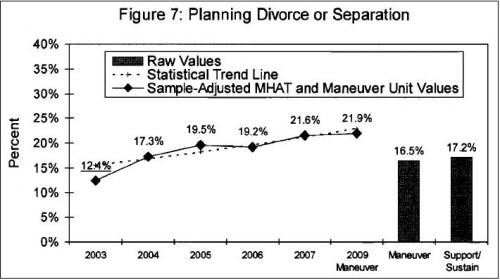 her story appearing in this week’s issue of Army Times notes that divorce rates in the Army and Marines continue to increase compared to the other services. The Air Force remained about even compared to a previous fiscal year, and the Navy decreased considerably. However the Marines experienced the most significant increase with the Army close behind.
her story appearing in this week’s issue of Army Times notes that divorce rates in the Army and Marines continue to increase compared to the other services. The Air Force remained about even compared to a previous fiscal year, and the Navy decreased considerably. However the Marines experienced the most significant increase with the Army close behind.Robert L. Hanafin
VT Staff Writer Divorces edge up again in 9th year of war
 According to the Pentagon, the divorce rate in the armed forces continues to increase despite efforts by the military to help struggling couples. There were an estimated 27,312 divorces among roughly 765,000 married members of the active-duty Army, Air Force, Navy and Marine Corps in the 12 months that ended Sept. 30, 2009.
According to the Pentagon, the divorce rate in the armed forces continues to increase despite efforts by the military to help struggling couples. There were an estimated 27,312 divorces among roughly 765,000 married members of the active-duty Army, Air Force, Navy and Marine Corps in the 12 months that ended Sept. 30, 2009.
That’s a divorce rate of about 3.6 percent, compared with 3.4 percent a year earlier, according to figures from the Defense Manpower Data Center. Marriages among reservists failed at a rate of 2.8 percent compared to 2.7 the previous year.
Maj. April Cunningham, U.S. Air Force, a Defense Department spokeswoman, said the latest year-to-year change was relatively small because the services have made available programs focused on strengthening and enriching family bonds among couples.
Still, the figures show a slow but steady increase in recent years as American forces fought the two wars in Iraq and Afghanistan.
The recently reported 3.6 percent rate is a full percentage point above the 2.6 percent reported in late 2001, when the U.S. began sending troops to Afghanistan.
As in previous years, women in uniform suffered much higher divorce rates than their male counterparts: 7.7 percent compared to 3 percent for men in 2009.
There’s no comparable annual system for tracking the national or civilian divorce rate, though the Centers for Disease Control said in 2005 that 43 percent of all first marriages end in divorce within 10 years.
A spokesman for the Veterans of Foreign Wars said that, "Every marriage has controllable and uncontrollable factors, but when you interject eight years of war, preparing for war, being at war, coming home and having to think about going back to war again, and when you have children, it just has a tremendous impact on the family unit." However, the VFW also said that the military prides itself on taking care of military families.
Programs run by chaplains, mental health officials and family services agencies provide service members access to retreats, couples’ counseling, workshops and other programs aimed at easing the strain of separation. Troops and spouses are advised on how long absences may affect family relationships and how to adjust to problems that arise after homecomings. The VFW spokesman also noted that "there’s nothing you can do that will end the stress of having a loved one at war … until the war ends."
Critics complain annually that the divorce rate reported by the Pentagon comes nowhere close to depicting the damage done to marriages and families by the two ongoing wars.
An Iraq and Afghanistan Veterans of America (IAVA) spokesman noted that DOD "numbers seem extremely conservative, and they are not at all representative from what we’re hearing from the community."
The IAVA spokesman estimated that the marital fallout is closer to double digits than to the rate the Pentagon makes public. For example, the Pentagon number doesn’t count Veterans who divorce after leaving the services, let alone reflect other possible wartime consequences on families, such as increases in alcoholism, [PTSD and other mental health issues] or the toll on orphaned or emotionally stressed children of troops. And the numbers do not speak to troubled but intact marriages. In an Army battlefield survey taken in Iraq in the spring, nearly 22 percent of young combat soldiers questioned said they planned to get a divorce or separation, compared to 12.4 percent in a survey conducted in 2003.

Readers are more than welcome to use the articles I’ve posted on Veterans Today, I’ve had to take a break from VT as Veterans Issues and Peace Activism Editor and staff writer due to personal medical reasons in our military family that take away too much time needed to properly express future stories or respond to readers in a timely manner.
My association with VT since its founding in 2004 has been a very rewarding experience for me.
Retired from both the Air Force and Civil Service. Went in the regular Army at 17 during Vietnam (1968), stayed in the Army Reserve to complete my eight year commitment in 1976. Served in Air Defense Artillery, and a Mechanized Infantry Division (4MID) at Fort Carson, Co. Used the GI Bill to go to college, worked full time at the VA, and non-scholarship Air Force 2-Year ROTC program for prior service military. Commissioned in the Air Force in 1977. Served as a Military Intelligence Officer from 1977 to 1994. Upon retirement I entered retail drugstore management training with Safeway Drugs Stores in California. Retail Sales Management was not my cup of tea, so I applied my former U.S. Civil Service status with the VA to get my foot in the door at the Justice Department, and later Department of the Navy retiring with disability from the Civil Service in 2000.
I’ve been with Veterans Today since the site originated. I’m now on the Editorial Board. I was also on the Editorial Board of Our Troops News Ladder another progressive leaning Veterans and Military Family news clearing house.
I remain married for over 45 years. I am both a Vietnam Era and Gulf War Veteran. I served on Okinawa and Fort Carson, Colorado during Vietnam and in the Office of the Air Force Inspector General at Norton AFB, CA during Desert Storm. I retired from the Air Force in 1994 having worked on the Air Staff and Defense Intelligence Agency at the Pentagon.
ATTENTION READERS
We See The World From All Sides and Want YOU To Be Fully InformedIn fact, intentional disinformation is a disgraceful scourge in media today. So to assuage any possible errant incorrect information posted herein, we strongly encourage you to seek corroboration from other non-VT sources before forming an educated opinion.
About VT - Policies & Disclosures - Comment Policy



